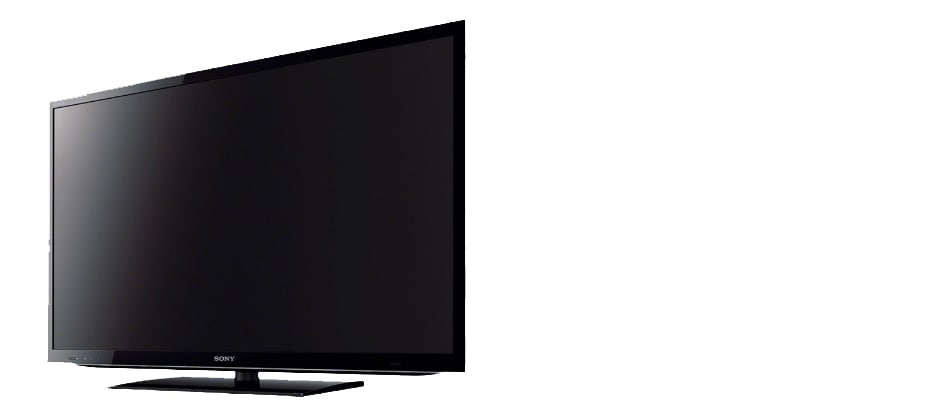Introduction
It isn't time for Sony's coronation just yet. In our tests, we found that Sony scored very respectably in the screen performance department. The KDL-46HX750 had a good contrast ratio and great color accuracy. In other aspects, like 3D and internet functionality, Sony is not quite there yet. The 3D quality is decent, but had some hiccups. The smart TV platform that Sony uses is complicated, to say the least.
Design
{{section_header}}{{section.name}}{{/section_header}}
Sony plays it safe as far as design goes.
Do not expect to be wowed or amazed by the design of the HX750. Sony plays it very safe in the design department; there are no super thin bezels and the base is a simple rectangle. Does this mean that the HX750 is ugly? Not at all. It is merely an average looking TV in an increasingly crowded market.
If viewing the HX750 from the back, the inputs and outputs are located on the left. On the side of the TV, you can find two USB ports, a VGA port, an analog audio input, a 3.5mm headphone jack, and two HDMI ports. Located next to these are composite and component inputs, which are separate and not shared—a rarity these days. Below the composite and component inputs, you will find an Ethernet jack, an antenna input, an S/PDIF output, and two more HDMI ports.
{{photo_gallery "Design Landing Page Photo", "Front Tour Image", "Back Tour Image", "Sides Tour Image", "Connectivity Tour Image 1", "Connectivity Tour Image 2", "Connectivity Extra Photo", "Stand Photo", "Controls Photo", "Remote Control Photo"}}
Smart TV Features
{{section_header}}{{section.name}}{{/section_header}}
Sony's smart platform is having an identity crisis.
Why are there two different smart TV interfaces on this TV? I can’t answer that question, although I can give you my thoughts on each.
The first of these smart TV platforms is tied to the Home Menu interface. You simply need to navigate to the sections that say Applications, Sony Entertainment Network, or Internet Content. Navigating these menus is complicated enough when you are trying to adjust the picture mode, let alone use an app.
Luckily, Sony has a solution to their own problem: a separate smart TV interface called the Sony Entertainment Network, not to be confused with the section in the Home Menu. This interface can be found by pressing the “SEN” button on the remote. The Sony Entertainment Network is eye-pleasing and easy to use, which begs the question of why Sony included the other interface at all.
{{photo_gallery "Software and Internet Landing Page Photo", "Internet Features 1 Photo", "Internet Features 2 Photo", "Internet Features 3 Photo", "Browser 1 Photo", "Browser 2 Photo", "Browser 3 Photo", "Apps 1 Photo", "Apps 2 Photo", "Apps 3 Photo", "Local Media Playback 1 Photo", "Local Media Playback 2 Photo", "Menu Main Photo", "Menu 2 Photo"}}
Picture Quality
{{section_header}}{{section.name}}{{/section_header}}
The HX750 produces an above-average picture.
Aside from a miniscule viewing angle, the Sony Bravia HX750 displayed a great picture. The color accuracy was excellent on the HX750: Colors displayed in accordance with the industry standard for HDTVs. Black and white levels, which make up a televisions contrast, were also good. The HX750 was able to get really deep black levels, meaning that darker images will show more detail.
This Sony performed well in our motion performance tests. Moving images had some blurriness, while straight lines would get slightly jagged when moving across the screen.
Sony does have a motion processing feature on this TV called Motionflow. There are five settings for this: Smooth, Standard, Clear, Clear Plus, and Impulse. Impulse and both clear settings decreased the backlight when turned on. Smooth and Standard seemed to produce the most jarring examples of the dreaded Soap Opera Effect. Clear, Clear Plus, and Impulse did not have as noticeable an effect.
3D
{{section_header}}{{section.name}}{{/section_header}}
Sony has adopted active 3D technology for use with their TVs. This technology involves the glasses presenting your eyes with rapidly alternating images, which tricks your brain perceiving a three-dimensional image. On the Sony Bravia HX750, the result is a fairly good 3D experience, but there are some issues.
The main problem we had while watching 3D on this TV was with the glasses. Sony does not include any glasses with the TV, which is a bummer but not a deal breaker. What might be a potential deal breaker for some people is that the glasses are bulky and uncomfortable, which becomes a problem when watching a two-hour movie in 3D.
The other issue encountered was crosstalk, which pops up frequently enough to be a distraction. Crosstalk is when an image meant for one eye pops up in the other eye, which causes an effect called “ghosting.” While the crosstalk issue did not completely ruin the 3D experience, it is worth pointing out that Sony’s 3D is far from perfect.
Conclusion
{{section_header}}{{section.name}}{{/section_header}}
The Sony Bravia KDL-46HX750 (MSRP $1,599) seems influenced by the motto “function over form.”
Aesthetically, it is an average looking TV, but it produces a good contrast and displays colors accurately. Sony’s menu system also lacks a nice form, yet there is an abundance of options to choose from, giving the user plenty of control to customize the TV to his or her specifications.
There are a couple of drawbacks to the HX750, namely the smart TV platform and the 3D. Sony's inclusion of two separate interfaces for accessing internet content needs to be addressed, while the 3D on the HX750 suffers from occasional crosstalk. It is easy to recommend the Sony Bravia KDL-46HX750 on its performance scores alone, but consumers will be buying (and paying for) this TV because of its added features. When everything is considered, $1,599 seems a little too expensive.
Science Introduction
{{section_header}}{{section.name}}{{/section_header}}
The Sony Bravia KDL-46HX750 had some very good performance scores. The two areas that it really excelled in were its good contrast and its excellent colors. While this TV did not have the best viewing angle, it did have respectable motion performance.
Color
{{section_header}}{{section.name}}{{/section_header}}
Colors are quite accurate on the HX750.
The gamut of colors that the Sony HX750 produces is very accurate. Greens and reds are spot-on, while blues are undersaturated and will appear less vibrant than they should. The white point is where it should be and as a result, the amount of color temperature error on this TV was negligible. More on how we test color performance.
{{photo_gallery "Science Section 1 Images"}}
Contrast
{{section_header}}{{section.name}}{{/section_header}}
The HX750 can produce deep blacks.
The Sony HX750’s contrast ratio of 3386:1 was good, especially compared to some other TVs in its price range. While it did not get as bright as the other TVs with a white level of 203.16 cd/m2 its outstanding black level of 0.06 cd/m2 more than made up for it. More on how we test contrast.
{{photo_gallery "Science Section 2 Images"}}
Other Tests
{{section_header}}{{section.name}}{{/section_header}}
{{photo_gallery "Other Tests Images"}}
Meet the tester
An enthusiast of all things tech, Josh is one of Reviewed.com's resident television experts. When he's not looking at bright TV screens in a dark room, he's probably reviewing a laptop or finding a new snack at 7-11.
Checking our work.
Our team is here for one purpose: to help you buy the best stuff and love what you own. Our writers, editors, and lab technicians obsess over the products we cover to make sure you're confident and satisfied. Have a different opinion about something we recommend? Email us and we'll compare notes.
Shoot us an email


